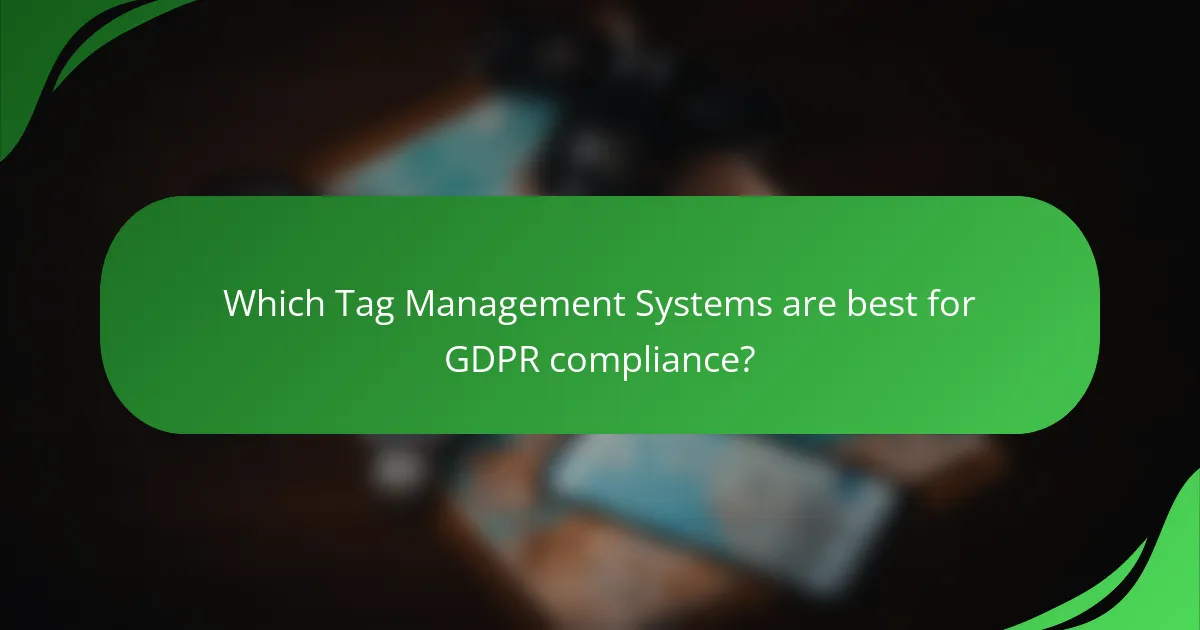Tag Management Systems (TMS) are essential tools for advertisers aiming to comply with GDPR regulations. By streamlining consent management and enabling efficient tracking of data handling practices, TMS help ensure that businesses adhere to privacy laws while minimizing the risk of non-compliance. With features like consent tracking and customizable data retention settings, these systems simplify the complexities of data privacy management.

How do Tag Management Systems support GDPR compliance for advertisers in Canada?
Tag Management Systems (TMS) help advertisers in Canada comply with GDPR by streamlining consent management, ensuring data minimization, and facilitating automated compliance updates. These systems allow businesses to manage tracking tags efficiently while adhering to privacy regulations, thus reducing the risk of non-compliance.
Centralized consent management
Centralized consent management is crucial for GDPR compliance, as it allows advertisers to collect and manage user consent in one place. A TMS can integrate with consent management platforms to ensure that all tracking tags respect user preferences regarding data collection. This way, advertisers can avoid using tags that do not align with the consent given by users.
By implementing a centralized system, advertisers can easily update consent settings across multiple tags, ensuring that they remain compliant with GDPR requirements. This reduces the administrative burden and minimizes the risk of errors that could lead to non-compliance.
Data minimization practices
Data minimization is a key principle of GDPR, requiring that only necessary data be collected and processed. Tag Management Systems facilitate this by allowing advertisers to control which data is collected through their tags. Advertisers can configure tags to gather only essential information, reducing the risk of collecting excessive data.
For example, a TMS can be set up to limit the collection of personal data to what is strictly necessary for a specific campaign. This practice not only helps in complying with GDPR but also builds trust with users by demonstrating a commitment to their privacy.
Automated compliance updates
Automated compliance updates are vital for maintaining GDPR adherence as regulations evolve. Tag Management Systems can be programmed to automatically update tags and tracking scripts in response to changes in privacy laws or best practices. This ensures that advertisers are always using compliant tags without needing constant manual oversight.
By leveraging automation, advertisers can significantly reduce the risk of using outdated or non-compliant tags, which could lead to legal penalties. Regular updates help maintain a proactive approach to compliance, allowing businesses to focus on their core activities.
Integration with privacy tools
Integration with privacy tools enhances the effectiveness of Tag Management Systems in achieving GDPR compliance. TMS can connect with various privacy management solutions, such as consent management platforms and data protection tools, to create a comprehensive compliance strategy. This integration ensures that all aspects of data collection and processing are aligned with GDPR requirements.
For instance, integrating a TMS with a consent management tool allows advertisers to automatically adjust their data collection practices based on user consent. This seamless interaction between systems helps maintain compliance while improving user experience and trust.

What are the key features of Tag Management Systems for GDPR compliance?
Tag Management Systems (TMS) play a crucial role in ensuring GDPR compliance for advertisers by providing tools to manage user consent and data handling practices effectively. Key features include consent tracking, version control, and customizable data retention settings, all designed to help businesses navigate the complexities of data privacy regulations.
Consent tracking capabilities
Consent tracking capabilities are essential for complying with GDPR, as they allow advertisers to record and manage user consent for data collection. A robust TMS can integrate with consent management platforms to ensure that tags are only fired when users have given explicit permission.
For example, if a user opts out of tracking, the TMS should prevent any associated tags from executing, thus safeguarding user privacy. This functionality not only helps in compliance but also builds trust with users by respecting their choices.
Version control and audit trails
Version control and audit trails are vital features that enable advertisers to maintain a clear history of changes made to tags and configurations. This transparency is important for demonstrating compliance with GDPR requirements, as it allows businesses to show how data handling practices have evolved over time.
With version control, teams can revert to previous configurations if needed, minimizing the risk of errors. Audit trails provide a documented history of who made changes and when, which can be crucial during compliance audits or investigations.
Customizable data retention settings
Customizable data retention settings allow advertisers to define how long user data is stored, aligning with GDPR’s principles of data minimization and storage limitation. A TMS should enable businesses to set specific retention periods based on their data policies and regulatory obligations.
For instance, advertisers can configure their systems to automatically delete data after a defined period, such as six months or one year, reducing the risk of retaining unnecessary information. This feature not only aids in compliance but also enhances data security by limiting exposure to potential breaches.

Which Tag Management Systems are best for GDPR compliance?
Tag Management Systems (TMS) play a crucial role in helping advertisers comply with GDPR regulations by managing user consent and controlling data collection. The best systems provide features that facilitate transparency, user consent management, and data minimization.
Google Tag Manager
Google Tag Manager (GTM) is a widely used TMS that offers robust features for GDPR compliance. It allows advertisers to manage tags without needing extensive coding knowledge, making it easier to implement consent management solutions. GTM integrates with various consent management platforms, enabling users to control which tags fire based on consent status.
To ensure compliance, set up triggers in GTM that only activate tags when users have given explicit consent. Regularly audit your tags to avoid unnecessary data collection and maintain transparency with users about how their data is used.
Tealium
Tealium is another powerful TMS that emphasizes data privacy and compliance with GDPR. It provides a comprehensive suite of tools for managing customer data and consent preferences. Tealium’s Consent Manager allows you to capture and respect user consent, ensuring that tags only fire when appropriate.
When using Tealium, consider implementing its Data Layer feature to standardize data collection across various platforms. This can help streamline compliance efforts and reduce the risk of collecting data without consent.
Adobe Experience Platform Launch
Adobe Experience Platform Launch is a flexible TMS that supports GDPR compliance through its robust tagging and data governance capabilities. It enables marketers to manage tags efficiently while ensuring that data collection aligns with user consent preferences. Adobe’s integration with Adobe Experience Cloud enhances its ability to maintain compliance across various marketing channels.
For effective GDPR compliance with Adobe Launch, utilize its built-in privacy controls to manage data collection and sharing. Regularly review your tag configurations and user consent settings to ensure they remain aligned with GDPR requirements.

What are the challenges of using Tag Management Systems for GDPR compliance?
Tag Management Systems (TMS) present several challenges for GDPR compliance, primarily due to their complexity and the potential for mishandling personal data. Advertisers must navigate these hurdles to ensure they are not violating privacy regulations while effectively managing their tags.
Complexity of implementation
Implementing a Tag Management System can be intricate, especially when integrating it with existing data protection measures. Advertisers must ensure that all tags are configured correctly to avoid unintended data collection, which can lead to compliance issues.
To simplify implementation, consider conducting a thorough audit of all existing tags and their purposes. This helps identify which tags are necessary and which can be removed, reducing complexity and potential risks.
Potential for data leaks
Data leaks are a significant risk when using Tag Management Systems, as improperly configured tags can expose personal data. Advertisers must be vigilant in monitoring tag behavior and data flows to prevent unauthorized access to sensitive information.
Regularly reviewing and updating tag settings can help mitigate this risk. Implementing strict access controls and using encryption for data transmission are also effective strategies to protect against data leaks.
Ongoing maintenance requirements
Maintaining a Tag Management System requires continuous oversight to ensure compliance with GDPR and other regulations. Advertisers must regularly update tags and monitor their performance to adapt to changing legal requirements and technological advancements.
Establishing a routine maintenance schedule can streamline this process. This might include quarterly reviews of tag configurations, performance analytics, and compliance checks to ensure that all tags remain aligned with GDPR standards.

How to choose a Tag Management System for GDPR compliance?
Choosing a Tag Management System (TMS) for GDPR compliance involves evaluating how well the system can manage user consent and data protection. Look for features that facilitate compliance with GDPR requirements, such as consent management and data minimization capabilities.
Evaluate vendor compliance certifications
When selecting a TMS, check if the vendor has relevant compliance certifications, such as ISO 27001 or the EU-U.S. Privacy Shield Framework. These certifications indicate that the vendor adheres to recognized data protection standards, which can help mitigate risks associated with GDPR non-compliance.
Additionally, review the vendor’s privacy policy and terms of service to ensure they align with GDPR principles. A transparent vendor will clearly outline how they handle personal data and user consent.
Assess integration capabilities
Integration capabilities are crucial for a TMS to function effectively within your existing marketing stack. Ensure that the TMS can seamlessly integrate with other tools you use, such as analytics platforms and customer relationship management systems.
Consider whether the TMS supports common data formats and APIs, which can simplify data sharing while maintaining compliance. A well-integrated TMS will help streamline your data processes and enhance your overall GDPR compliance strategy.
Consider user interface and support
A user-friendly interface is essential for efficiently managing tags and ensuring compliance with GDPR. Look for a TMS that offers an intuitive dashboard and easy navigation, which can reduce training time and improve team productivity.
Additionally, evaluate the level of customer support provided by the vendor. Reliable support can be invaluable when you encounter compliance challenges or technical issues. Check for resources such as documentation, tutorials, and responsive customer service to assist you in using the TMS effectively.

What are the best practices for implementing Tag Management Systems?
Implementing Tag Management Systems (TMS) effectively requires a strategic approach that prioritizes organization, compliance, and performance. Best practices include defining clear objectives, ensuring data privacy, and maintaining a streamlined tagging process.
Define clear objectives for your TMS
Establishing clear objectives is crucial for a successful TMS implementation. Identify what you want to achieve, such as improving data collection, enhancing user experience, or ensuring compliance with regulations like GDPR. This focus will guide your tagging strategy and help measure success.
For instance, if your goal is to optimize marketing efforts, prioritize tags that track user behavior, conversions, and engagement metrics. This targeted approach allows for more effective data analysis and decision-making.
Ensure compliance with data protection regulations
Compliance with data protection regulations, particularly GDPR, is essential when implementing a TMS. Ensure that all tags are configured to respect user consent and data privacy. This may involve integrating consent management tools that allow users to opt-in or opt-out of data tracking.
Regularly review and update your tagging practices to align with evolving regulations. For example, ensure that any third-party tags are compliant and do not collect personal data without consent. This proactive approach minimizes legal risks and builds trust with users.
Maintain a streamlined tagging process
A streamlined tagging process enhances efficiency and reduces errors. Organize tags logically, using naming conventions and categorization to make management easier. This practice helps teams quickly identify and modify tags as needed.
Consider implementing version control for tags to track changes and ensure that updates do not disrupt existing data collection. Regular audits of your tags can help identify outdated or redundant tags, keeping your TMS clean and efficient.



